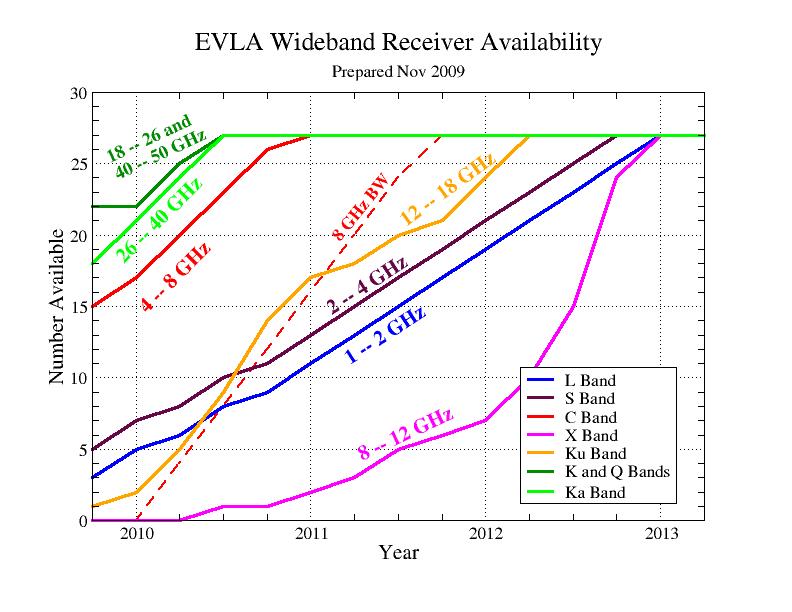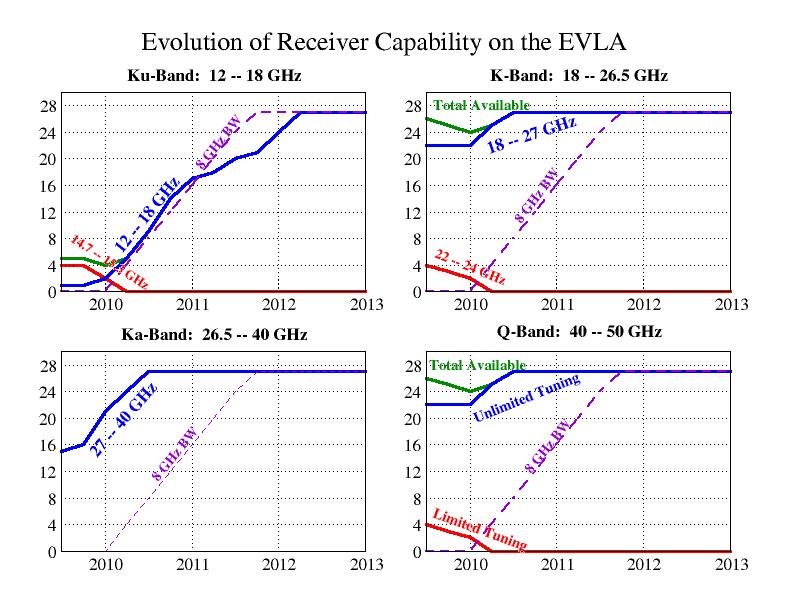The Open Shared Risk Observing Program
NRAO has esentially been offering shared risk access to the VLA for all users since the EVLA construction project began. The Open Shared Risk Observing (OSRO) program extends this in the EVLA era by providing early access to a number of WIDAR capabilities and observing modes for the general user community after the VLA correlator has been turned off in January 2010. These modes represent a significant improvement over the capabilities of the VLA correlator. At the same time as the transition from the VLA correlator to WIDAR the direction of the configuration cycles will also change, from A→B→C→D→A… to D→C→B→A→D…, to facilitate correlator commissioning and to limit data rates during Early Science. The VLA will therefore spend two trimesters in D configuration, one with the VLA correlator (October 2009 - January 2010) and one with WIDAR. The second of these will initially be used for commissioning the OSRO observing modes with the full array. Astronomical observations with WIDAR are expected to begin in March 2010.
Expected EVLA capabilities
Antennas
VLA antennas are currently being retrofitted to EVLA specifications at a rate of approximately one antenna every two months. At the end of 2008 there were 18 EVLA antennas regularly used for astronomical observing, and it is planned that by the end of 2009 this number will have increased to 24. Despite the large instantaneous bandwidths and enhanced tuning ranges of the new EVLA RF and IF system and receivers relative to the VLA, as long as the VLA correlator continues in use the maximum instantaneous bandwidth that can be correlated is 50 MHz per IF. For this and several other technical reasons the VLA correlator will be turned off in January 2010, and all remaining VLA antennas will be decommissioned until they are retrofitted to become EVLA antennas. VLA antennas will not be used with WIDAR.
Receivers
When EVLA antennas are retrofitted they are currently outfitted with "interim" L, EVLA or "interim" C, VLA X, EVLA K, and EVLA Q-band receivers. [Interim receivers are EVLA receivers with VLA orthomode transducers. All interim receivers will be converted to full EVLA capabilities by the end of the project. The polarization purity and sensitivity of the interim receivers typically is good only over the traditional VLA tuning range.] As of August 2009 thirteen of the EVLA antennas also have EVLA Ka-band receivers. Figure 1 shows the expected rate of antenna retrofits and installation of the final EVLA receiver systems throughout the EVLA construction project. Figure 1 does not show the whole picture, however. Those antennas that do not have final EVLA receiver systems typically do have VLA or interim receivers, and Figures 2 and 3 show the total numbers of receivers at each band as a function of time. The maximum bandwidth that can be brought back from the antennas to the correlator depends on the rate at which the antennas are outfitted with fast 3-bit samplers (the "4 GHz BW" or "8 GHz BW" lines in Figures 2 and 3).

Figure 1: Availability of EVLA antennas and final EVLA receiver systems as a function of time.

Figure 2: Low-frequency receiver availability. The red line shows the number of VLA receivers, the light green line shows the interim receivers, and the blue line shows the EVLA receivers.

Figure 3: High-frequency receiver availability. The red line shows the number of VLA receivers, typically with more limited tuning capability, and the blue line shows the final EVLA receivers.
New receiver bands will be offered for general use when the performance of at least five antennas has been verified by EVLA commissioning staff.
WIDAR correlator
Initially we will provide options for configuring WIDAR for OSRO in the following ways:
- A mode for continuum applications, to comprise two independently
tunable sub-bands, full polarization, each of which has 128 MHz
bandwidth with 64 channels, with the possibility of smoothing in
frequency to reduce dataset sizes or to improve spectral response
offline. In this mode it will also be possible to decrease the
bandwidth by powers of two, keeping the same number of channels,
to provide the spectro-polarimetry capabilities in Table 1.
Table 1: Correlator capabilities per sub-band for full-polarization continuum applications and spectro-polarimetry
Sub-band BW (MHz) Number of poln. products Number of channels/poln product Channel width (kHz) Channel width (km/s at 1 GHz) Total velocity coverage per sub-band (km/s at 1 GHz) 128 4 64 2000 600/ν(GHz) 38,400/ν(GHz) 64 4 64 1000 300 19,200 32 4 64 500 150 9,600 16 4 64 250 75 4,800 8 4 64 125 37.5 2,400 4 4 64 62.5 19 1,200 2 4 64 31.25 9.4 600 1 4 64 15.625 4.7 300 0.5 4 64 7.813 2.3 150 0.25 4 64 3.906 1.2 75 0.125 4 64 1.953 0.59 37.5 0.0625 4 64 0.977 0.29 18.75 0.03125 4 64 0.488 0.15 9.375 - A higher resolution mode for spectral line applications, to comprise
one tunable sub-band, dual polarization, with 128 MHz bandwidth and
256 channels, again with the possibility of smoothing in frequency
to reduce dataset sizes or to improve spectral response offline.
It will be possible to decrease the bandwidth by powers of two, keeping
the same number of channels, to provide the capabilities in Table 2.
Table 2: Correlator capabilities for spectral line applications, dual polarization
Sub-band BW (MHz) Number of poln. products Number of channels/poln product Channel width (kHz) Channel width (km/s at 1 GHz) Total velocity coverage (km/s at 1 GHz) 128 2 256 500 150/ν(GHz) 38,400/ν(GHz) 64 2 256 250 75 19,200 32 2 256 125 37.5 9,600 16 2 256 62.5 19 4,800 8 2 256 31.25 9.4 2,400 4 2 256 15.625 4.7 1,200 2 2 256 7.813 2.3 600 1 2 256 3.906 1.2 300 0.5 2 256 1.953 0.59 150 0.25 2 256 0.977 0.29 75 0.125 2 256 0.488 0.15 37.5 0.0625 2 256 0.244 0.073 18.75 0.03125 2 256 0.122 0.037 9.375
These capabilities will be provided with integration times no shorter than 1 second, and Doppler tracking will be available with these modes. The capabilities available to the OSRO program will be expanded as soon as they can be supported for general use. It is currently hoped that 2 GHz of bandwidth will be available by the time of the D configuration beginning in Trimester 2, 2011. The OSRO program will run from March 2010 through the end of the EVLA construction phase. Access to the OSRO program will be via the existing time allocation process and regular calls for proposals, beginning with the October 1, 2009 proposal deadline.
It will be possible to reduce simple OSRO datasets using AIPS, although users are encouraged to use CASA, which will also be available.
It should be recognized that the EVLA will be undergoing commissioning throughout the duration of the Early Science programs, and that the quality of data taken during this time cannot be fully guaranteed. Nevertheless, NRAO will make every effort to ensure projects awarded time under the OSRO program do obtain data, subject to the availability of our resources.
Modified on Tuesday, 05-Jan-2010 03:26:46 MST by Claire Chandler
